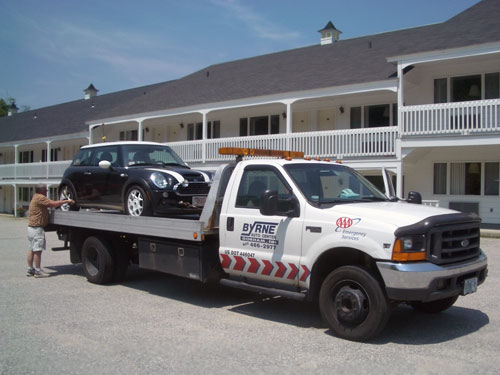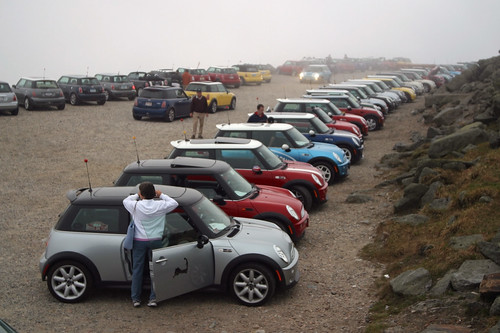As you know last week I was towed back from MINIsOnTop because my fuel pump died. What you might not know was that it was killed by the 10% ethanol gas that has become common. And I am very much not alone.
Massachusetts started adding 10% ethanol (E10) to its gasoline this summer. As soon as we saw those stickers show up on the gas tanks, many of us also noticed our MINIs having many problems starting and running until the engine warms up. For me, the first start never worked, it just “harleys” for a few seconds and dies. But then it starts perfectly on the second start. Many others are experiencing this, and also some hesitation for a minute or so before the engine warms up.
It was just a small annoyance, just a quirky personality trait. At least until It destroyed my fuel pump and left me stranded. We have no stations that give us a choice of non-ethanol fuel (which will hopefully go away again in the winter), so we can’t do anything about it really. So I started pressing on what is really going on, and I got a bit of a scoop.
This is a BIG problem. Where there was never any fuel pump issues before, as soon as the E10 gas was released, several minis per day have been coming in with dead pumps. Upon investigating the fuel inside the tank, it is almost always an orange-brown color, possibly from the corroded pump. In some rare cases, it is black from sludge that has been cleaned off of old tanks. Furthermore, if the tank is not cleaned out, a new pump will seize soon after. This issue is not just affecting MINIs in vast quantities, but many other brands as well…BMW, Porsche, and others.
Here’s the kicker: Officially, MINI’s warranty does not cover “bad gas.” Of course we have no way to know how bad it is, and if it is present in every pump in the state, it can hardly be considered bad. As a result, service is forced to word things differently to blame the pump itself, and the repair paperwork cannot say ethanol, in order to have it covered by warranty. (In other words, if this happens to you, maybe “forget” some brownies and beer in your car when you turn it in!)
What’s really going on here? First let’s have a look at Ethanol Gasoline. Ethanol is an alcohol usually derived from corn. Its use is mainly political, to support U.S. Farmers. It does not save money or reduce foreign oil dependency, as it doesn’t offset the additional costs to refine and transport. For example, it cannot be transferred through pipelines as it will corrode them, instead it must be transported by truck and added to local fuel depot batches. Ethanol has a lower energy content than gasoline, and therefore you get less power and miles per gallon using it. Ethanol alone is slightly corrosive, mainly to seals in fuel systems not designed to use them (This is where the new E85 vehicles are updated), but should be harmless at low percentages. However the property that concerns us most is that while water does not combine with normal gasoline, ethanol absorbs it. Furthermore the ethanol can separate from the gasoline at low temperatures and create a much higher concentration than if they were mixed evenly.
So although 10% Ethanol is mixed in at the fuel depot, it may separate while sitting in the tanks there, or in the trucks, or more in the gas station’s tank. Gas station’s tanks may not be completely sealed, and heavy rains may get water into the tank–and we all know New England has had record rainfalls this spring. In fact it is normal for stations to have water at the bottom of their tanks, but remember gas won’t combine with it so it doesn’t get pumped, until ethanol is added and absorbs that water. The only way to avoid this is at the beginning of each summer when the switch is made to E10, the station must flush and clean out its tanks. You know most stations won’t bother doing that. As a result of all of this, the actual concentration of ethanol going into your tank may be much higher than ten percent–you have no way to tell–and you have no idea how much water is absorbed in it as well. It should be worse at the beginning of the season or after a lot of rain, then slowly improve.
The quality of the fuel is not related to the station brand. There are “Top Tier” brands (note this does not include Mobil), but that refers to cleaning agents added to the gas above the required standard and has no effect on ethanol. It simply comes down to how well a station cares for its gas tanks, and the rate at which it is refilled with cleaner gas. You really have no idea if one station is better than another. The best you can do is go to stations that get more volume of customers so they are refilled more often; if there is water in their tanks it has a better chance of being absorbed and pumped out quicker.
There’s not much else we can do. Gas stations will slowly adapt to the new stricter water requirements. MINI and other car companies may need to develop an additive to reduce the corrosiveness of the water and ethanol in the fuel. Really the only answer is to redesign the fuel pump to better handle ethanol and water, and then recall and replace each fuel pump out there. As you can imagine, that would be a daunting task.
If you think your MINI has been affected by ethanol gas, we are sharing our experiences in this thread on MINI2. There are a few suggestions on getting your engine to run better, but there’s really not much you can do to protect your fuel pump. As for mine, the car has been running better since the install of the new pump, but despite being in the middle of a tank, when the rain came back over the weekend so did my double-start issue. That may mean the humidity in the air may also be a factor in this whole equation!



